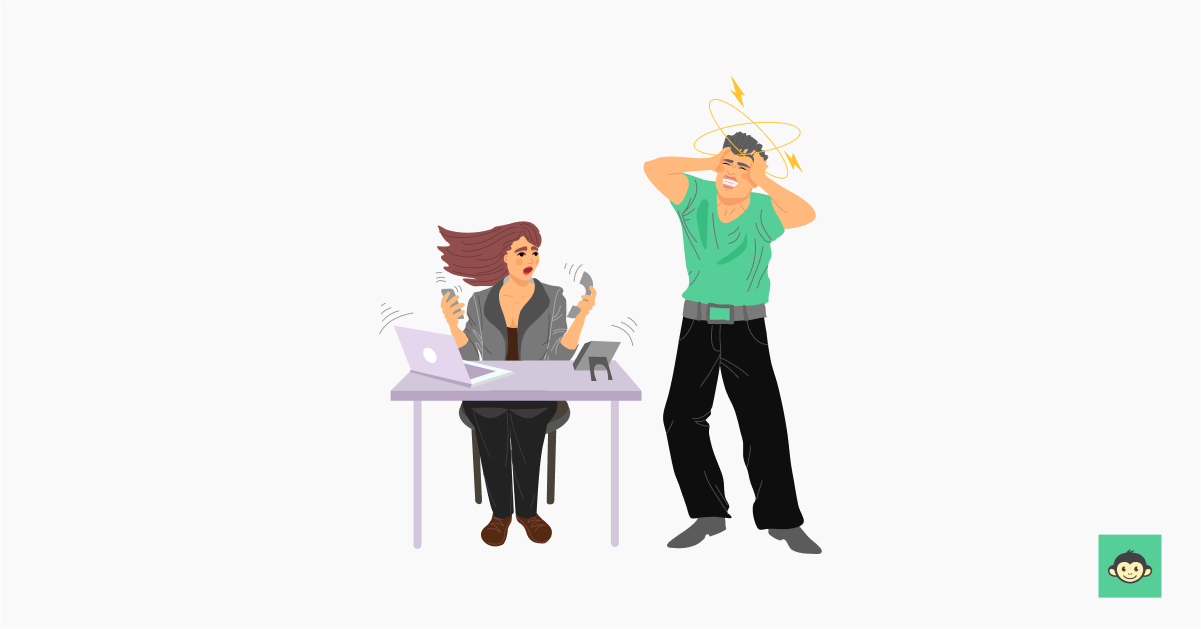What is toxic positivity: 25 Examples and ways to manage them at work as a leader in 2024

We've all seen the memes – "Good vibes only!" or "Just choose happiness!" While a more positive mindset and outlook can be a powerful asset, there's a fine line between optimism and a phenomenon known as toxic positivity.
In 2024, with a heightened focus on mental health and employee well-being, leaders need to be aware of this potential pitfall.
Toxic positivity isn't just about rainbows and sunshine. It's the pressure to maintain a relentlessly cheerful facade, suppressing or dismissing negative emotions. This approach can be incredibly damaging, invalidating genuine struggles and hindering open communication.
As a leader in 2024, it's crucial to recognize the signs of toxic positivity in your team and cultivate a work environment that embraces the full spectrum of human emotions.
This blog post will equip you with 25 real-world examples of toxic positivity, along with actionable strategies to address them effectively. Let's explore how to navigate the positivity paradox, fostering a workplace where authenticity and resilience can truly thrive.
Toxic positivity vs optimism

Toxic positivity and optimism, while both seemingly positive in nature, diverge significantly in their approach to handling negative emotions. Optimism involves maintaining a hopeful outlook and acknowledging challenges while believing in the possibility of positive outcomes.
It is a balanced perspective that allows for the expression of a full range of emotions, understanding that setbacks and difficulties are part of the human experience. In contrast, toxic positivity dismisses and invalidates negative emotions, insisting on a relentlessly upbeat attitude regardless of circumstances.
This approach can be harmful, as it pressures individuals to suppress genuine feelings of sadness, anger, or disappointment, potentially leading to emotional repression and a lack of authenticity in dealing with personal struggles.
Toxic positivity often manifests in well-meaning but ultimately dismissive statements like "just stay positive" or "it could be worse," which can trivialize the experiences of those suffering.
True optimism, however, encourages resilience by using positive emotion and fostering a realistic yet hopeful mindset, acknowledging pain while also emphasizing the capacity for growth and improvement.
This healthy balance between negative and positive emotions enables individuals to navigate life's challenges with a grounded sense of hope rather than an enforced veneer of cheerfulness.
Top signs that there’s toxic positivity in your workplace

Toxic positivity in the workplace can undermine genuine emotional well-being and create a superficially cheerful but emotionally unhealthy environment. Here are the top signs that it may be present:
- Dismissal of negative emotions: Employees are frequently told to "stay positive" or "look on the bright side" when they express concerns, frustrations, and their own feelings, leading to a culture where negative feelings are invalidated.
- Pressure to be happy all the time: There is an expectation or pressure for employees to constantly display a cheerful demeanor, regardless of their actual emotional state, which can feel forced and insincere.
- Lack of empathy from management: Leaders and managers fail to acknowledge the difficulties or challenges employees face, often responding with overly simplistic positive statements instead of offering support or solutions.
- Avoidance of difficult conversations: Critical issues, conflicts, or feedback are avoided or glossed over with positivity, preventing meaningful discussion and resolution of problems.
- Punishment for expressing dissent: Employees who express negative feelings or constructive criticism are often labeled as negative or problematic, discouraging open communication.
- Unrealistic optimism in goals: There is a persistent push for overly optimistic goals and timelines, ignoring practical limitations and the need for realistic planning.
- Surface-level wellness programs: Workplace wellness initiatives focus on superficial activities (like motivational posters or forced fun events) without addressing underlying issues such as workload, stress, or work-life balance.
- Forced participation in positivity activities: Employees are required to participate in team-building exercises or positivity workshops that feel artificial or compulsory rather than genuinely supportive.
What are the negative impacts of toxic positivity at work?
Toxic positivity at work can have several negative impacts that extend beyond mental health issues, affecting overall organizational culture and productivity. These impacts include:
1. Reduced employee engagement
When employees feel their genuine emotions are dismissed, they may become disengaged and less invested in their work, leading to decreased motivation and productivity.
2. Poor communication
A culture of toxic positivity can stifle open communication. Employees might refrain from voicing concerns or giving honest feedback, which can prevent the identification and resolution of problems, ultimately hindering organizational improvement.
3. Lower trust levels
Employees are likely to distrust a workplace that consistently ignores their challenges and insists on positivity. This erodes trust in leadership and the company as a whole, potentially increasing turnover rates.
4. Increased conflict
By avoiding difficult conversations and masking issues with positivity, underlying conflicts can fester and escalate. Without proper resolution, these conflicts can damage team cohesion and collaboration.
5. Decreased innovation
Innovation thrives on diverse perspectives and honest feedback. Toxic positivity discourages critical thinking and problem-solving discussions, leading to a lack of creativity and innovation within the team.
6. Employee burnout
When negative emotions are not acknowledged, employees might feel pressured to suppress painful emotions and stress and overextend themselves to meet unrealistic positive expectations. This can contribute to physical exhaustion and decreased performance over time.
How does toxic positivity impact the mental health of employees?

Toxic positivity significantly impacts the mental health of employees by creating an environment where they keep suppressing negative emotions. When employees are consistently encouraged to "stay positive" regardless of their genuine feelings, they may feel pressured to hide their true emotions.
This suppression can lead to increased stress and anxiety, as employees are unable to express or process their feelings healthily. Over time, this can cause serious emotional distress, exhaustion, and burnout as the effort to maintain a facade of constant happiness becomes overwhelming.
Additionally, toxic positivity can lead to feelings of isolation and loneliness. When employees perceive that only positive emotions are acceptable, they may avoid sharing their struggles or seeking support from colleagues and supervisors.
This lack of open communication can prevent the formation of genuine connections and support networks within the workplace, exacerbating feelings of isolation.
Furthermore, employees may experience guilt or shame for having negative emotions, believing that they are failing to meet the workplace's expectation of constant positivity. This self-criticism can erode self-esteem and contribute to a cycle of negative mental health outcomes, including depression.
Ultimately, an environment of toxic positivity undermines the psychological safety of employees, making it difficult for them to address and manage their mental health effectively.
Is toxic positivity gaslighting?

Toxic positivity and gaslighting share some similarities in their effects on individuals, but they are distinct concepts. Toxic positivity involves dismissing and invalidating negative emotions by insisting on a perpetually positive outlook, often leading to feelings of isolation and emotional suppression.
On the other hand, gaslighting is a form of psychological manipulation where someone makes another person doubt their reality, memory, or perceptions, often to gain control or power over them.
Despite these differences, toxic positivity can have gaslighting-like effects. When an individual’s genuine emotions and concerns are consistently invalidated with overly optimistic statements, it can cause them to question the legitimacy of their feelings.
For example, if an employee expresses stress or frustration and is met with responses like "just stay positive" or "it could be worse," they may start to doubt their own experiences and emotional responses. This can lead to confusion, self-doubt, and a sense of disconnection from reality, similar to the effects of gaslighting.
While toxic positivity is generally well-intentioned, aiming to promote a positive atmosphere, it can inadvertently undermine individuals’ experiences of secondary emotions and realities.
Failing to acknowledge and validate negative emotion creates an environment where people feel pressured to conform to an unrealistic standard of constant happiness, potentially leading to the same psychological distress and confusion characteristic of gaslighting.
What is the dark side of toxic positivity?
The dark side of toxic positivity lies in its tendency to invalidate and suppress genuine emotional experiences, leading to several detrimental effects on individuals and organizations. Here are some key aspects of this darker side of healthy positivity:
1. Emotional repression
Toxic positivity pressures individuals to hide their own negative emotions and put on a facade of constant happiness. This repression can prevent people from processing their feelings healthily, potentially leading to increased stress, anxiety, and even depression over time.
2. Isolation and loneliness
By fostering an environment where only positive emotions are acceptable, toxic positivity can make individuals feel isolated and disconnected. They may avoid sharing their true feelings for fear of being judged or dismissed, leading to a lack of genuine support and understanding from peers and leaders.
3. Erosion of authenticity
In a social media culture dominated by toxic positivity, individuals might feel compelled to present a false version of themselves. This lack of authenticity can strain relationships, reduce trust, and hinder meaningful connections both personally and professionally.
4. Inhibition of growth and learning
Embracing only positive perspectives can stifle critical thinking and problem-solving. Constructive criticism and negative feedback are essential for personal and professional growth, but toxic positivity discourages these necessary conversations, impeding development and improvement.
5. Increased burnout
The relentless push to remain positive can lead to burnout. Individuals may feel they cannot take breaks or seek help when needed, exacerbating stress and leading to physical and emotional exhaustion.
6. Diminished resilience
Resilience is built through experiencing and overcoming adversity. By denying the existence of challenges and difficulties, toxic positivity can undermine individuals' ability to develop coping mechanisms and resilience.
7. Unrealistic expectations
Promoting a culture of constant positivity sets unrealistic expectations for emotional states. This can lead to disappointment, clinical depression, and frustration when individuals inevitably encounter negative experiences, feeling that they have failed to live up to the ideal of perpetual happiness.
25 Examples of toxic positivity (and what to say instead)

Here are 25 examples of toxic positivity and suggestions for what to say instead to foster a more supportive and empathetic environment:
- "Just stay positive." Instead, say: "It's okay to feel upset. I'm here for you."
- "Don't worry, be happy!" Instead, say: "It's normal to feel worried. How can I help?"
- "Everything happens for a reason." Instead, say: "I'm sorry you're going through this. It must be really tough."
- "Look on the bright side." Instead, say: "I can see why you're feeling this way. Let's talk about it."
- "Think happy thoughts." Instead, say: "It's important to acknowledge how you're feeling. What's on your mind?"
- "It could be worse." Instead, say: "I'm sorry you're dealing with this. How can I support you?"
- "Good vibes only." Instead, say: "All emotions are valid. I'm here if you need to talk."
- "Just smile!" Instead, say: "It's okay to feel sad. Smiling isn't always the answer."
- "Others have it worse than you." Instead, say: "Your feelings are valid, no matter what others are going through."
- "Be grateful for what you have." Instead, say: "It's okay to feel down, even when you have things to be grateful for."
- "Everything will be fine." Instead, say: "It's understandable to feel unsure. Let's figure it out together."
- "Just let it go." Instead, say: "It's okay to hold on to your feelings. Let's work through them."
- "Don't be so negative." Instead, say: "It's okay to feel negative sometimes. What's bothering you?"
- "Positive vibes only." Instead, say: "All feelings are part of the human experience. I'm here for all of them."
- "Cheer up!" Instead, say: "I'm sorry you're feeling this way. Want to talk about it?"
- "Happiness is a choice." Instead, say: "It's okay to feel unhappy sometimes. Let's talk about what's going on."
- "Failure is not an option." Instead, say: "Failure is a part of learning. What can we learn from this experience?"
- "Don't dwell on the negative." Instead, say: "Processing negative emotions is important. How can I help you work through them?"
- "Just think positive!" Instead, say: "Thinking positive is hard when you're struggling. What's weighing on you?"
- "Everything will work out." Instead, say: "I understand your concerns. Let's find a solution together."
- "You'll get over it." Instead, say: "Take all the time you need to heal. I'm here if you need support."
- "Look how lucky you are." Instead, say: "It's okay to feel bad even when things are generally good. What's on your mind?"
- "Think positive thoughts and good things will happen." Instead, say: "It's okay to have negative thoughts. Let's talk about what's going on."
- "It's not that bad." Instead, say: "It sounds like you're going through a lot. I'm here to listen."
- "Stop being so negative." Instead, say: "Your feelings are valid. What's making you feel this way?"
How to deal with toxic positivity at work as a leader?

As a leader, dealing with toxic positivity at work requires a balanced approach that fosters genuine well-being without dismissing legitimate concerns. First, it's crucial to acknowledge and validate employees' feelings. Instead of insisting that everything is always fine, create an environment where expressing a range of emotions is acceptable.
This can be achieved by encouraging open dialogue and actively listening to team members' concerns. When employees feel heard, they are more likely to trust leadership and engage honestly.
Additionally, promotes a culture that values problem-solving over mere positivity. While maintaining a positive outlook is important, it should not come at the expense of addressing real issues. Encourage your team to identify challenges and collaboratively develop solutions.
This approach not only mitigates the effects of toxic positivity but also empowers employees to take ownership of their work environment. Furthermore, lead by example by demonstrating vulnerability and authenticity. Share your own challenges and how you navigate them, showing that it's normal to experience and work through difficulties.
It can help reduce the pressure to maintain a facade of constant positivity. Lastly, provide resources and support for mental health, such as access to counseling services or stress management workshops. By addressing toxic positivity thoughtfully, leaders can cultivate a healthier, more resilient workplace where employees feel truly supported.
How does a regular feedback loop help you support employees at work from toxic positivity?

A regular feedback loop is instrumental in supporting employees and mitigating toxic positivity at work by fostering transparent communication and addressing concerns in real time.
By establishing a consistent schedule for feedback, employees have regular opportunities to voice their thoughts, share challenges, and express their needs without fear of judgment or repercussions.
This continuous exchange helps leaders stay attuned to the team's genuine sentiments, making it easier to identify and address any underlying issues promptly. The feedback loop encourages a culture of open dialogue, where employees feel safe to discuss both positive and negative experiences.
This openness is crucial in countering toxic positivity, which often suppresses negative emotions and concerns in favor of an overly optimistic outlook. Regular feedback sessions validate employees' feelings, showing that their well-being is a priority and that it's acceptable to experience and discuss difficulties.
Additionally, feedback loops empower employees by involving them in the decision-making process. When leaders actively seek and act on feedback, it demonstrates that employee input is valued and can lead to meaningful changes.
This collaborative approach helps in both positive thinking and creating practical solutions to problems, reinforcing that the workplace values authenticity over forced positivity.
By maintaining a regular feedback loop, leaders can cultivate an environment where constructive criticism and genuine support coexist, ultimately fostering a healthier, more balanced workplace culture.
Conclusion
While positivity is generally encouraged, it's essential to recognize the dangers of toxic positivity. This mindset, often characterized by the dismissal of negative emotions in favor of relentless optimism, can have profound detrimental effects on individuals' mental health and overall well-being.
From emotional repression to the erosion of authenticity and strained relationships, the dark side of toxic positivity underscores the importance of fostering environments where all emotions are acknowledged and validated.
By replacing toxic positivity with empathy, understanding, and genuine support, we can create workplaces and communities where individuals feel safe to express their true feelings and where authentic connections thrive.



